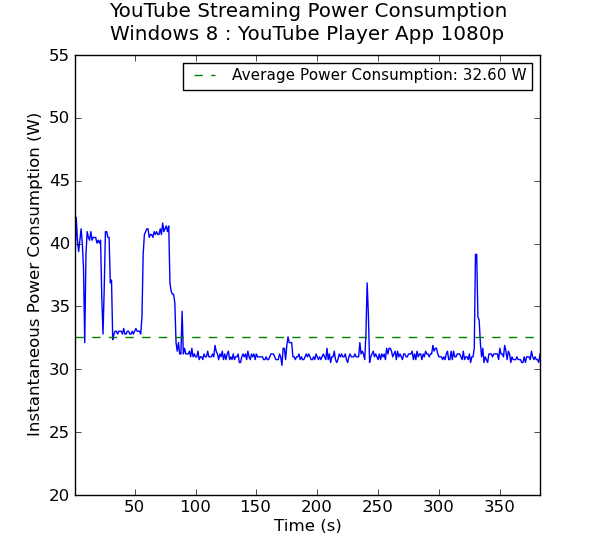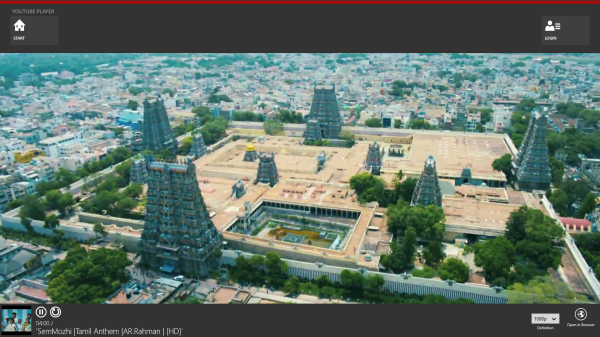Getting the Best out of an Ivy Bridge HTPC: Windows 8, madVR and More..
by Ganesh T S on January 20, 2013 3:00 PM EST- Posted in
- Home Theater
- Intel
- HTPC
- Ivy Bridge
- Windows 8
- Passive Cooling
Network Streaming Performance - YouTube
YouTube is one of the most popular video streaming services, and Google maintains a number of encodes for each stream. On platforms supporting Adobe Flash, FLV streams are available at resolutions ranging from 240p to 480p. HTML5 streams are either in WebM (for Firefox) or MP4 / H.264 (for Internet Explorer). WebM streams typically top out at 720p, while MP4 is the preferred format for 1080p. At higher resolutions, Adobe Flash also streams the MP4 version.
As expected, we get GPU acceleration when using Adobe Flash in Firefox on Windows 7. The debug OSD presents the requisite details.
HD YouTube Streaming using Adobe Flash in Mozilla Firefox on Windows 7
Windows 8 has an app for YouTube, 'YouTube Player' which allows for stream quality selection. Just like the Netflix app, there is no direct way to determine if GPU acceleration is being used.
HD YouTube Streaming using the YouTube Player App on Windows 8
We will rely on the power consumption at the wall to determine the efficiency of various ways to stream YouTube videos across different operating systems. Since the matrix of options is quite big, we present the graphs one at a time. All the graphs are on the same scale. Press the button below corresponding to the combination you want to compare the current graph against.

It can be seen that the Windows 8 YouTube Player App wins hands down. The stream being decoded is, in all probability, the 1080p H.264 version. Even when Adobe Flash is being used, Windows 8 seems to be more efficient compared to Windows 7. If you are on Windows, and prefer to use HTML5, it is better to avoid Mozilla Firefox because the WebM version consumes the most power at the wall (due to lack of hardware accelerated decode) while providing only a 720p stream. Once again, if YouTube forms a major part of your HTPC experience, an upgrade from Windows 7 to Windows 8 can be recommended.












138 Comments
View All Comments
lexluthermiester - Monday, January 21, 2013 - link
I've run many tests doing the 8 VS 7 comparisons. Not only have you left out many of the comparing scores for 7, but your power usage numbers don't seem right.I have a Kill-A-Watt power usage adapter that plugs right into the wall, which measures total power running through it. Last night I ran tests using Netflix and 8 vs 7 on two different notebooks. The first is a Gateway P-7811FX[P9700 2.8 ghz C2D, GF 9800m GTS] and the second a Toshiba L655-S5150[i5-480m 2.66ghz, Intel HD]. The numbers for the Gateway were 67.3[8], 64.4[8 app] and 66.1[7]. The Toshiba's numbers were a bit better, 50.9[8], 47.1[8 app] and 50.8[7].
Now I could go one for days about game benchmarks and compatibility between 7 & 8. But real issue here is the your power numbers don't seem realistic. The Netflix app does have a small advantage, but nothing as dramatic as what you are showing. The difference between 8 VS 7 numbers are statistically insignificant. I ran battery tests as well. And those numbers are also statistically insignificant.
I'm not willing to accept your results as valid and quantifiable, unless you declare the testing equipment used and OS config setup.
lexluthermiester - Monday, January 21, 2013 - link
And before anyone states the obvious, yes the CPU's in each of those notebook were upgraded from their factory offerings. Both have 4GB of ram. The gateway has a WD 500gb 7200rpm HDD and the Toshiba has a Seagate 320GB 7200rpm. But remember these notebooks were not compared to each other, only themselves using one OS vs the other.ganeshts - Monday, January 21, 2013 - link
I stand by my numbers, and the tests were repeated multiple times to confirm this. Our configuration of the testbed itself is described in the first page of the review.For power measurement, we use the UFO Power Center from Visible Energy with a custom power measurement script described here:
http://www.anandtech.com/show/6413/visible-energy-...
I see that both the CPUs you used have old Intel HD Graphics (yes, Clarkdale and Arrandale were released when Intel HD Graphics wasn't that great). I think a lot of the advantage for the app version has to do with very good hardware decode acceleration (improved GPU and drivers).
Gigaplex - Monday, January 21, 2013 - link
You're claiming that minimal power savings with old architecture CPUs on notebooks (were the batteries plugged in?) as measured by you invalidates Ganesh's measurements on a desktop platform? Just... no.Galatian - Monday, January 21, 2013 - link
Does the Windows 8 GUI actually bring something on the table for a couch potato like myself? I just retired my old gaming rig which now serves as a HTPC and I kinda tasted blood with Steam in Big Picture mode. I'm planning on running a power efficient yet graphically powerful HTPC once Haswell (or perhaps a new AMD A10) is out, but I would really like for Windows 8 to be completely controllable by an XBox controller? Has Microsoft actually included support for that or was their only new feature touch support?lexluthermiester - Monday, January 21, 2013 - link
You can control Windows 7 with a 360 controller? Didn't know that. Is this something natively supported? Or is it a hack? Wait... I'm on the net I'll look it up... Very cool if it works though.Galatian - Monday, January 21, 2013 - link
Never said it did...not sure were you red this in my post??? I was just curious because for me the tile based start menu of Windows 8 would seem to be a perfect fit for a XBox controller support, hence my question. At least this would be one place in my house were Windows 8 might be useful. If not I'll jus stick to Windows 7Gigaplex - Monday, January 21, 2013 - link
If your TV is 720p rather than 1080p, then absolutely not. "Metro" apps don't run at 1280x720, an error message pops up telling you to change the screen resolution whenever you try to launch one.And no, sadly an Xbox controller doesn't work with "Metro".
coolhund - Tuesday, January 22, 2013 - link
LOL seriously?I mean I know that the minimum is 1024x768, but hell, everyone knows 720p is often used and thus I thought they were smart enough to allow that resolution, even if its not quite as high in the vertical. The stupidity of MS never ceases to amaze me...
powerarmour - Tuesday, January 22, 2013 - link
Unfortunately the Metro/Modern UI is neither remote friendly, nor controller friendly.Waste of time for a HTPC tbh.